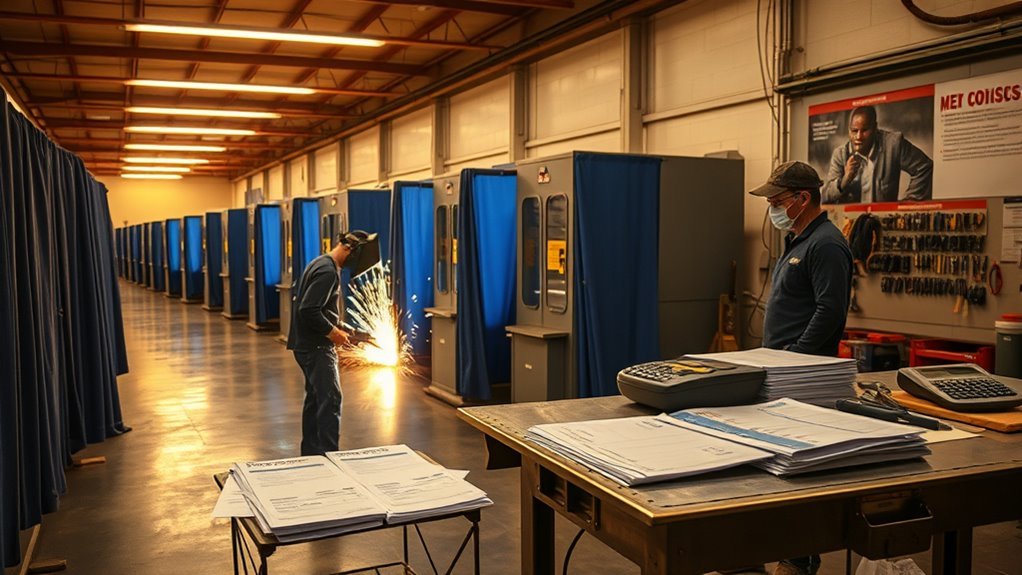You’ll pay roughly $485 for short workshops up to about $3,500 for full certificate or diploma programs in Alabama, while community-college semesters often run near $2,500 before aid. Expect extra fees for safety gear, textbooks, specialty electrodes, and occasional tool kits. Apply for grants, scholarships, or employer assistance to cut costs — some awards cover up to $4,500. Compare net price, equipment access, and placement rates to pick the best program, and keep going to learn specifics.
Typical Tuition Ranges for Certificate and Diploma Programs

Most students in Alabama can expect welding certificate and diploma programs to run a few thousand dollars per term; in-state tuition and fees average about $2,500 per semester.
You’ll see tuition variations depending on program length and whether it’s a certificate (around $3,500 total in many cases) or a longer diploma.
Check program accreditation first, since accredited programs often qualify for Paths to Prosperity scholarships, WIOA funding, and other aid that can cover up to $4,500 or more.
You should compare net costs after aid rather than sticker price. Ask schools for a written estimate showing tuition variations, included textbooks or tool kits, and any eligibility requirements tied to program accreditation so you know what you’ll actually pay.
Breakdown of Additional Fees and Materials Costs

When you budget for welding school, don’t just plan for tuition—you’ll also need to cover course-specific fees and gear.
Expect a basic course (~$485) to include hands-on supplies, but a full 12-week program (~$3,500) typically covers the textbook and a required tool kit; confirm what’s bundled before you pay.
Plan small extra costs for administrative items like state photo ID and personal information forms that schools often require.
Buy or rent additional equipment you’ll need beyond the kit—welding clamps, grinding tools, or specialty electrodes—based on course lists.
Prioritize safety gear: a quality welding helmet, gloves, and flame-resistant clothing are essential for lab work and may not be included.
Keep receipts and verify what the program supplies.
Financial Aid, Scholarships, and Payment Options

After you’ve listed fees and gear, look next at how to pay for a welding program. Start by comparing costs: in-state tuition averages about $2,500 per semester, while some specialized courses run near $3,500 including textbooks and tool kits.
Apply for federal aid and government or private loans if needed, but prioritize grants and scholarships first.
Check the Paths to Prosperity Scholarship—eligible Alabama residents can receive up to $4,500 for ACCS-approved programs.
Look into college-specific awards (Bishop State and others) for academics, leadership, or service.
Ask schools about tuition assistance plans, payment schedules, and employer tuition reimbursement.
Build basic financial literacy: create a budget, track loan terms, and confirm total out-of-pocket costs before enrolling.
Comparing Community Colleges and Private Training Centers

Although both community colleges and private training centers can teach you welding, they differ in cost, length, financial aid availability, equipment access, and career support — so weigh those factors against your budget and timeline.
You’ll likely pay about $2,500 per semester at a community college versus roughly $3,500 upfront at a private center.
Consider community college advantages: access to financial aid and scholarships (like Paths to Prosperity), industry-standard equipment, and job placement rates often above 80%.
Community colleges offer financial aid, industry-standard equipment, and strong job placement—often exceeding 80% for welding grads.
Private training drawbacks include limited financial assistance, fewer resources, and less robust career support, though courses can be shorter and intensive.
Decide whether lower net cost, equipment access, and placement support matter more than a faster, pricier program.
Course Lengths and How They Affect Price

Decide whether you need a short-term workshop or a full-length program based on your goals and budget.
Short workshops (about 8 weeks) cost roughly $485 and teach practical skills for home or farm use, while 12-week programs run around $3,500 and include advanced techniques, a textbook, and a tool kit.
Remember that longer courses offer broader hands-on experience and more financial aid options, which can offset higher upfront costs.
Short-Term Workshops
When you need basic welding skills fast, short-term workshops in Alabama offer a practical, affordable option that typically runs a few weeks and costs around $485.
You’ll focus on core welding techniques, safety, and hands-on practice so you can start welding for home or farm projects quickly. Classes are usually small—often capped at eight students—to give you lots of one-on-one coaching and maximize lab time.
Workshop benefits include lower cost, faster completion, and direct practice rather than extended theory. You won’t get the depth or certification of longer programs, but you’ll gain usable skills for hobby or entry-level tasks.
Choose a workshop when you need efficient, practical training without a large time or financial commitment.
Full-Length Programs
Because full-length welding programs give you far more lab time and equipment access, they’ll typically run about 12 weeks with classes most evenings Monday through Thursday.
You’ll pay more than for short workshops because that schedule includes hands-on practice with industry-standard equipment and extended instructor time.
Expect in-state tuition around $2,500 per semester, rising to about $3,500 when textbooks, tool kits, and specialized certification fees are included.
Programs that cover multiple welding techniques and safety standards can hit that higher figure.
Check scholarship and financial-aid options like the Paths to Prosperity Scholarship, which can cover up to $4,500 and often eliminates cost barriers.
Before you enroll, compare curricula, proof of industry standards compliance, and what’s included in the total price.
What’s Included in Program Costs (Tools, Textbooks, Certification)
Although tuition varies by program, you’ll usually pay not just for classroom time but for the essentials—textbooks, a basic tool kit, lab supplies, and any included certification exams.
In Alabama, program components commonly bundle those items: a 12-week extensive course (about $3,500) often includes the textbook and tool kit, while an introductory class (around $485) covers lab equipment.
Expect semester tuition near $2,500 for in-state students; scholarship options like Paths to Prosperity can offset costs up to $4,500.
Certification benefits typically include a program completion certificate plus the opportunity for AWS welding certification, which many programs include in the overall fee.
Verify exactly what’s listed so you won’t buy duplicate supplies or unexpected exam fees.
Refunds, Transfers, and Enrollment Policies
If you need to change plans, act quickly: Alabama welding courses require a written refund request at least 10 days before the start date for a full refund, and no refunds are issued after that deadline.
For the $3,500 program, a 100% refund applies with written notice two weeks before start and 75% with notice one week prior.
After the refund deadline, you can use transfer options to move into the next open scheduled class, but only one transfer is allowed without an additional refund.
To enroll, you must meet the minimum age of 18, provide a state-issued photo ID, and register by the announced deadline.
Review refund policies and transfer options before you register so you know your options.
Expected Earnings and Return on Investment
When you weigh the cost of welding school against likely wages, the return is clear: entry-level welders in Alabama typically start around $15 per hour (about $31,200 annually), many find jobs before graduation, and experienced welders can earn up to $50 per hour (roughly $104,000), with common mid-career incomes near $45,000—well above average tuition of about $2,500 per semester and supported by an over 80% placement rate. You should view training as an investment: industry demand and high placement rates speed payback. Track certifications, take internships, and pursue career advancement paths like pipefitting or inspection to raise your ceiling. Use the quick reference below to compare outcomes.
| Metric | Typical Value |
|---|---|
| Entry pay | $15/hr |
| Mid-career | ~$45,000/yr |
| Top earners | $50/hr |
| Placement rate | >80% |
Frequently Asked Questions
Can I Work Part-Time While Attending Welding School in Alabama?
Yes — you can work part-time while attending welding school; you’ll balance classes, labs, and safety training. Look for flexible part time jobs, communicate schedules, limit hours during intensive lab periods, and prioritize hands-on practice.
Are Evening or Weekend Class Schedules Available?
Yes — you can find evening classes and weekend schedules at many Alabama welding schools; check program catalogs, ask admissions about part-time options, confirm hands-on lab times, and plan work shifts around required shop hours and certifications.
Do Programs Include Training for Pipe Welding Certifications?
Yes — like a well-tuned engine, you’ll learn pipe welding fundamentals, practice joint techniques, and prep for the certification process; instructors guide you through hands-on tests, documentation, safety protocols, and tips to pass qualification exams.
Is On-Campus Job Placement Assistance Offered After Graduation?
Yes — many campuses offer on-campus job placement assistance after graduation. You’ll use job services, resume help, interview coaching, and alumni network connections to find local welding positions, apprenticeships, or certification-related roles quickly and practically.
Are There Prerequisites or Age Requirements to Enroll?
Want to enroll now? You’ll meet enrollment requirements like a high school diploma or GED, placement testing, and health clearance; age restrictions vary by school and state—most accept students 17–18+ with parental consent if under 18.
Conclusion
You’ll find welding school costs in Alabama vary, but you can plan and choose wisely so your investment pays off. Consider tuition, fees, tools, and certification—each piece matters like links in a chain. Compare community colleges and private centers, check program length, and use financial aid or scholarships to lower outlay. Read refund and transfer policies, and weigh expected earnings to judge return on investment before you enroll.


